Healthcare Communication Analysis: Troy Almond Case Study Report
VerifiedAdded on 2022/09/23
|8
|2327
|28
Report
AI Summary
This report examines the critical role of communication in healthcare, emphasizing both verbal and electronic methods, and its impact on patient outcomes. It analyzes a case study involving the death of Troy Almond, highlighting missed communication opportunities among healthcare professionals, particularly in documentation practices and the use of early warning tools. The report discusses the importance of registered nurses' accountability, professional practice, and critical thinking skills in ensuring patient safety. It also explores the significance of early warning systems like CEWT and the implementation of Ryan's rule to enhance communication between patients, families, and healthcare providers. Furthermore, the report proposes strategies to mitigate risks associated with communication gaps, such as promoting collaborative teamwork and standardized documentation protocols. The analysis underscores the need for effective communication to reduce errors and improve the overall quality of care in healthcare settings.
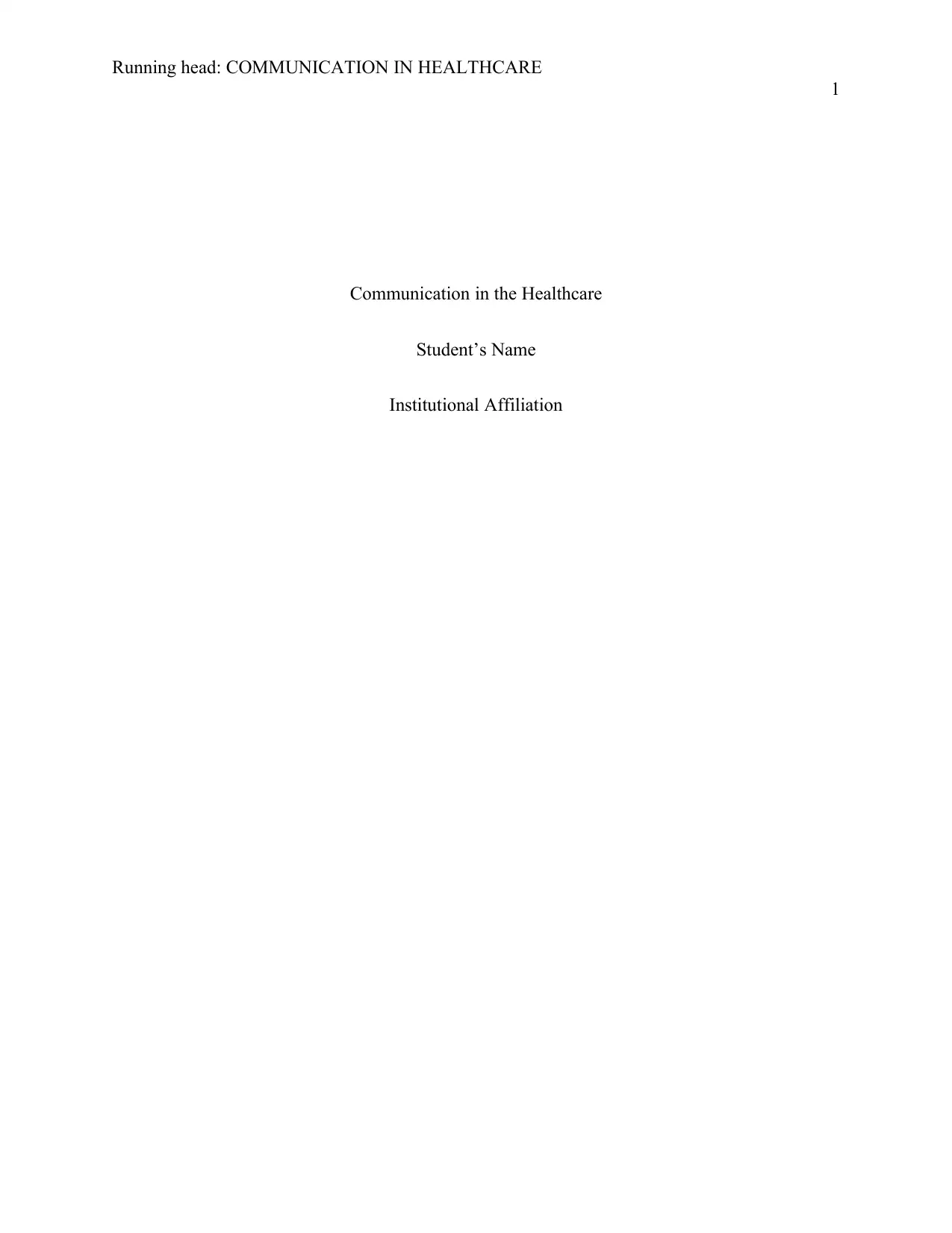
Running head: COMMUNICATION IN HEALTHCARE
1
Communication in the Healthcare
Student’s Name
Institutional Affiliation
1
Communication in the Healthcare
Student’s Name
Institutional Affiliation
Paraphrase This Document
Need a fresh take? Get an instant paraphrase of this document with our AI Paraphraser
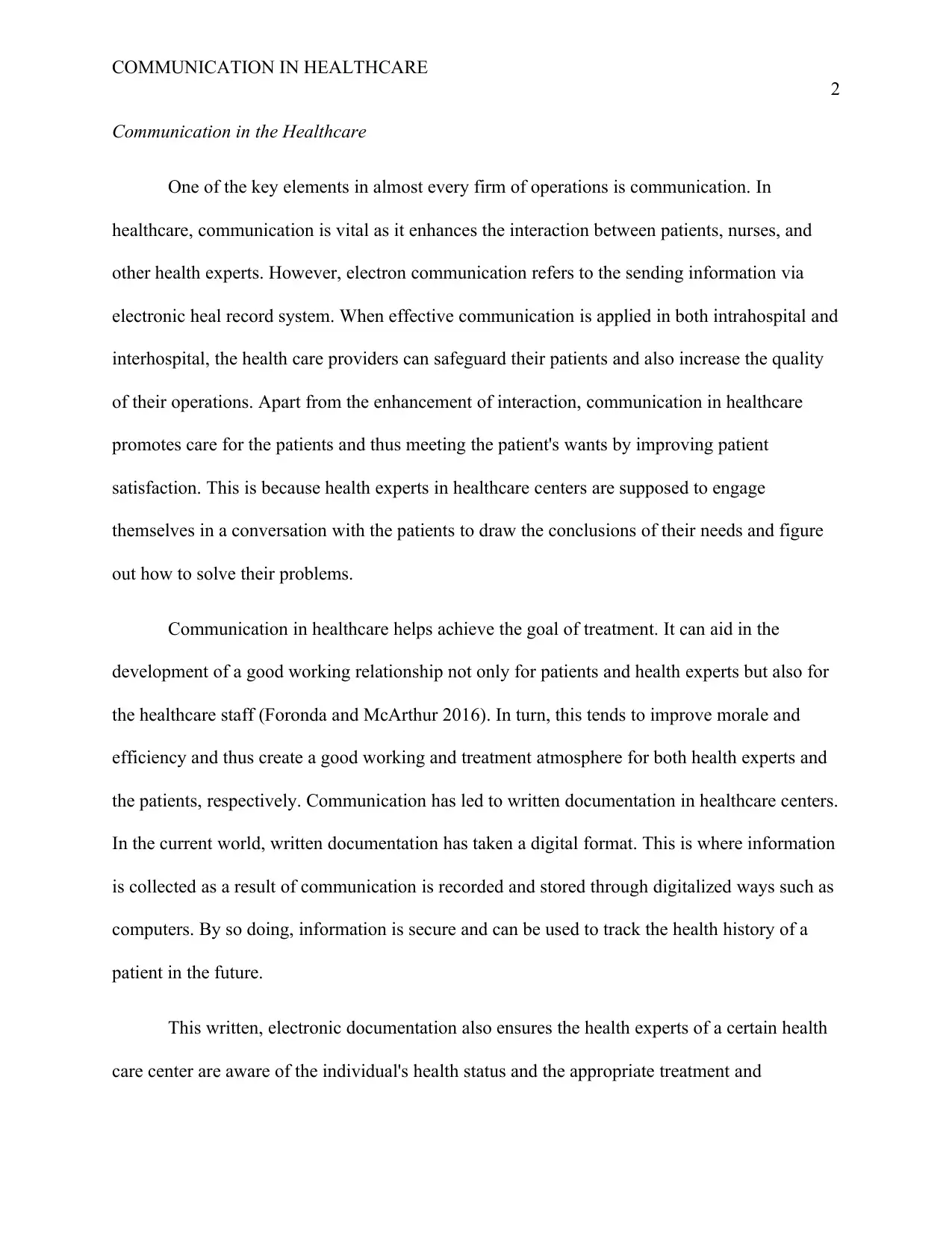
COMMUNICATION IN HEALTHCARE
2
Communication in the Healthcare
One of the key elements in almost every firm of operations is communication. In
healthcare, communication is vital as it enhances the interaction between patients, nurses, and
other health experts. However, electron communication refers to the sending information via
electronic heal record system. When effective communication is applied in both intrahospital and
interhospital, the health care providers can safeguard their patients and also increase the quality
of their operations. Apart from the enhancement of interaction, communication in healthcare
promotes care for the patients and thus meeting the patient's wants by improving patient
satisfaction. This is because health experts in healthcare centers are supposed to engage
themselves in a conversation with the patients to draw the conclusions of their needs and figure
out how to solve their problems.
Communication in healthcare helps achieve the goal of treatment. It can aid in the
development of a good working relationship not only for patients and health experts but also for
the healthcare staff (Foronda and McArthur 2016). In turn, this tends to improve morale and
efficiency and thus create a good working and treatment atmosphere for both health experts and
the patients, respectively. Communication has led to written documentation in healthcare centers.
In the current world, written documentation has taken a digital format. This is where information
is collected as a result of communication is recorded and stored through digitalized ways such as
computers. By so doing, information is secure and can be used to track the health history of a
patient in the future.
This written, electronic documentation also ensures the health experts of a certain health
care center are aware of the individual's health status and the appropriate treatment and
2
Communication in the Healthcare
One of the key elements in almost every firm of operations is communication. In
healthcare, communication is vital as it enhances the interaction between patients, nurses, and
other health experts. However, electron communication refers to the sending information via
electronic heal record system. When effective communication is applied in both intrahospital and
interhospital, the health care providers can safeguard their patients and also increase the quality
of their operations. Apart from the enhancement of interaction, communication in healthcare
promotes care for the patients and thus meeting the patient's wants by improving patient
satisfaction. This is because health experts in healthcare centers are supposed to engage
themselves in a conversation with the patients to draw the conclusions of their needs and figure
out how to solve their problems.
Communication in healthcare helps achieve the goal of treatment. It can aid in the
development of a good working relationship not only for patients and health experts but also for
the healthcare staff (Foronda and McArthur 2016). In turn, this tends to improve morale and
efficiency and thus create a good working and treatment atmosphere for both health experts and
the patients, respectively. Communication has led to written documentation in healthcare centers.
In the current world, written documentation has taken a digital format. This is where information
is collected as a result of communication is recorded and stored through digitalized ways such as
computers. By so doing, information is secure and can be used to track the health history of a
patient in the future.
This written, electronic documentation also ensures the health experts of a certain health
care center are aware of the individual's health status and the appropriate treatment and
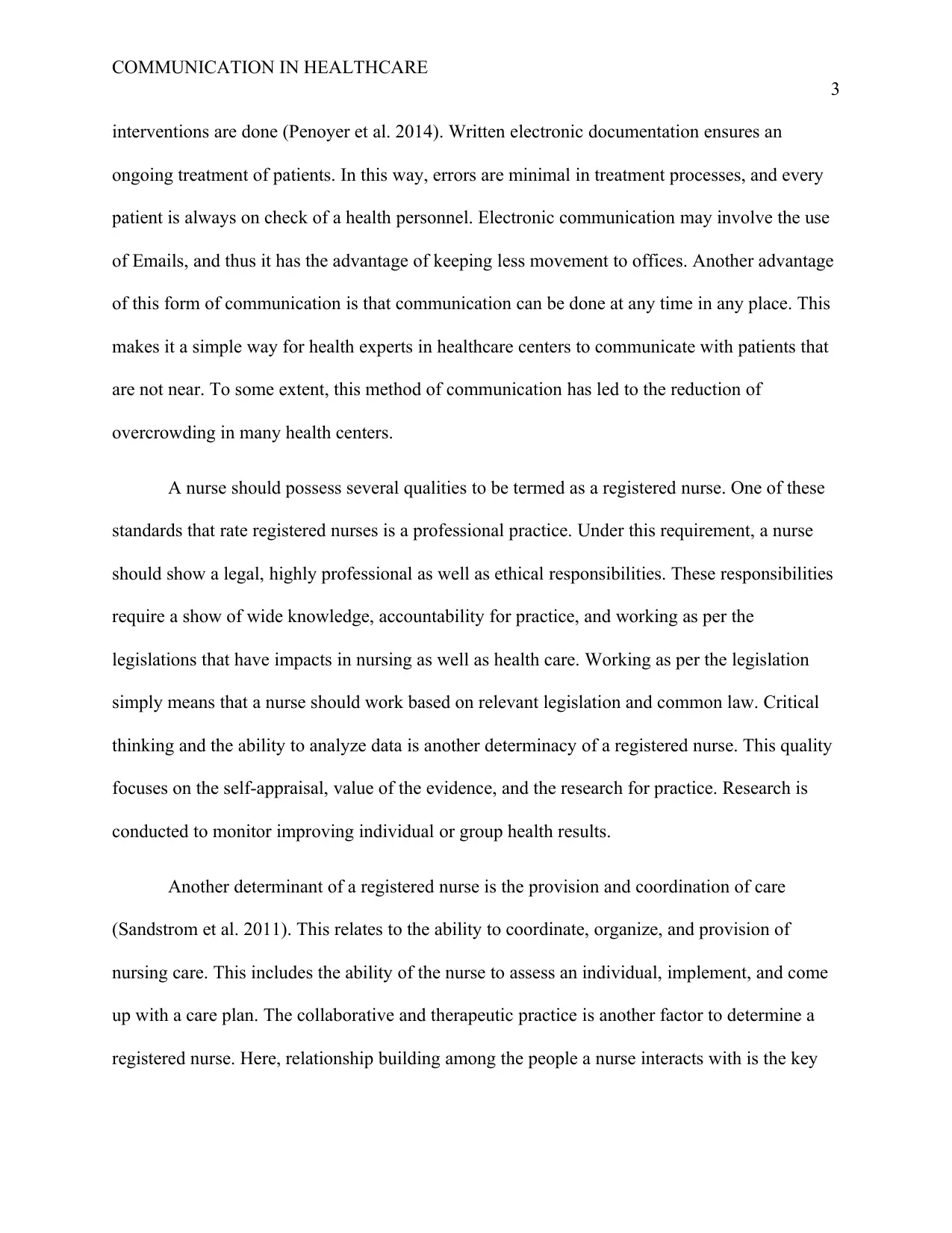
COMMUNICATION IN HEALTHCARE
3
interventions are done (Penoyer et al. 2014). Written electronic documentation ensures an
ongoing treatment of patients. In this way, errors are minimal in treatment processes, and every
patient is always on check of a health personnel. Electronic communication may involve the use
of Emails, and thus it has the advantage of keeping less movement to offices. Another advantage
of this form of communication is that communication can be done at any time in any place. This
makes it a simple way for health experts in healthcare centers to communicate with patients that
are not near. To some extent, this method of communication has led to the reduction of
overcrowding in many health centers.
A nurse should possess several qualities to be termed as a registered nurse. One of these
standards that rate registered nurses is a professional practice. Under this requirement, a nurse
should show a legal, highly professional as well as ethical responsibilities. These responsibilities
require a show of wide knowledge, accountability for practice, and working as per the
legislations that have impacts in nursing as well as health care. Working as per the legislation
simply means that a nurse should work based on relevant legislation and common law. Critical
thinking and the ability to analyze data is another determinacy of a registered nurse. This quality
focuses on the self-appraisal, value of the evidence, and the research for practice. Research is
conducted to monitor improving individual or group health results.
Another determinant of a registered nurse is the provision and coordination of care
(Sandstrom et al. 2011). This relates to the ability to coordinate, organize, and provision of
nursing care. This includes the ability of the nurse to assess an individual, implement, and come
up with a care plan. The collaborative and therapeutic practice is another factor to determine a
registered nurse. Here, relationship building among the people a nurse interacts with is the key
3
interventions are done (Penoyer et al. 2014). Written electronic documentation ensures an
ongoing treatment of patients. In this way, errors are minimal in treatment processes, and every
patient is always on check of a health personnel. Electronic communication may involve the use
of Emails, and thus it has the advantage of keeping less movement to offices. Another advantage
of this form of communication is that communication can be done at any time in any place. This
makes it a simple way for health experts in healthcare centers to communicate with patients that
are not near. To some extent, this method of communication has led to the reduction of
overcrowding in many health centers.
A nurse should possess several qualities to be termed as a registered nurse. One of these
standards that rate registered nurses is a professional practice. Under this requirement, a nurse
should show a legal, highly professional as well as ethical responsibilities. These responsibilities
require a show of wide knowledge, accountability for practice, and working as per the
legislations that have impacts in nursing as well as health care. Working as per the legislation
simply means that a nurse should work based on relevant legislation and common law. Critical
thinking and the ability to analyze data is another determinacy of a registered nurse. This quality
focuses on the self-appraisal, value of the evidence, and the research for practice. Research is
conducted to monitor improving individual or group health results.
Another determinant of a registered nurse is the provision and coordination of care
(Sandstrom et al. 2011). This relates to the ability to coordinate, organize, and provision of
nursing care. This includes the ability of the nurse to assess an individual, implement, and come
up with a care plan. The collaborative and therapeutic practice is another factor to determine a
registered nurse. Here, relationship building among the people a nurse interacts with is the key
⊘ This is a preview!⊘
Do you want full access?
Subscribe today to unlock all pages.

Trusted by 1+ million students worldwide
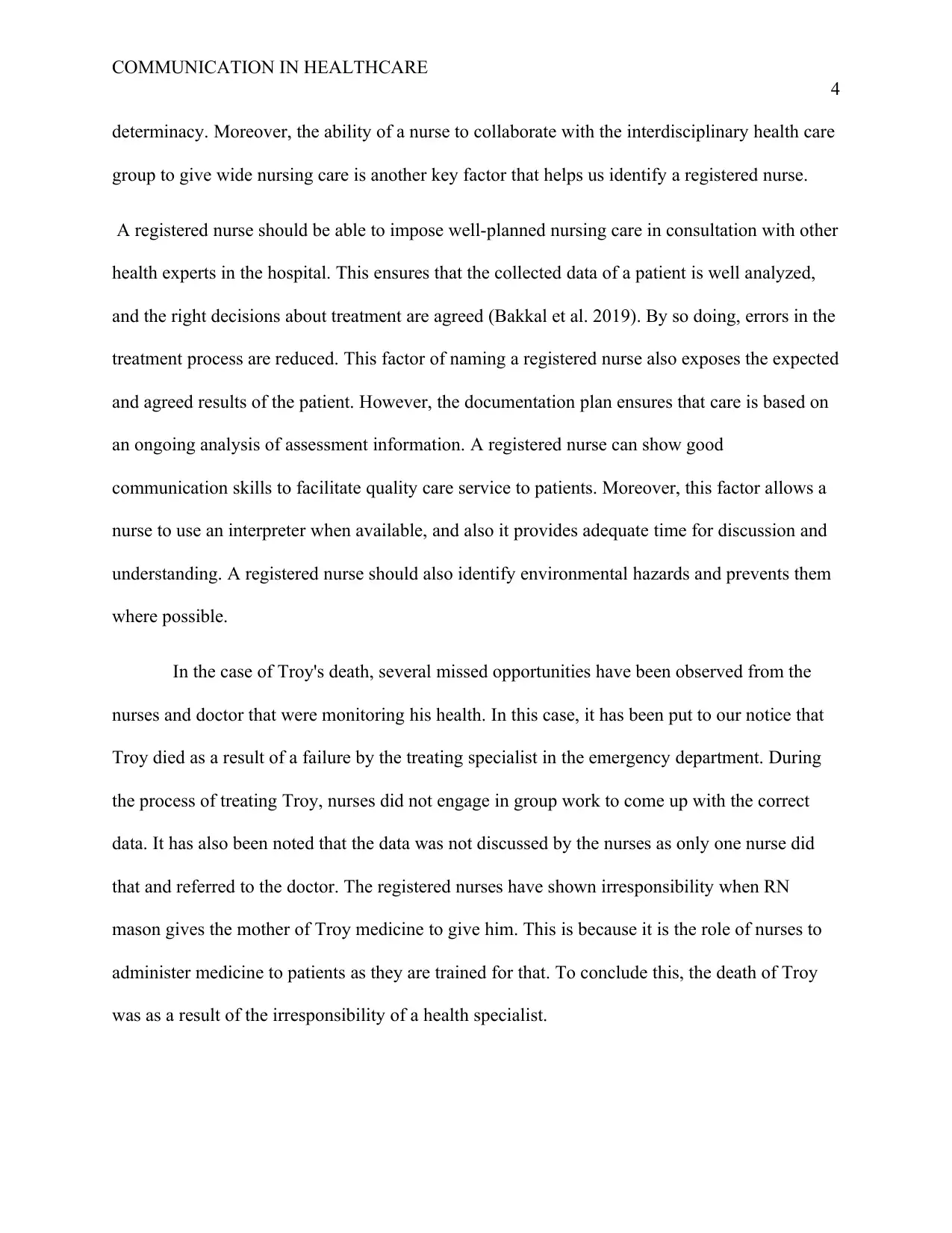
COMMUNICATION IN HEALTHCARE
4
determinacy. Moreover, the ability of a nurse to collaborate with the interdisciplinary health care
group to give wide nursing care is another key factor that helps us identify a registered nurse.
A registered nurse should be able to impose well-planned nursing care in consultation with other
health experts in the hospital. This ensures that the collected data of a patient is well analyzed,
and the right decisions about treatment are agreed (Bakkal et al. 2019). By so doing, errors in the
treatment process are reduced. This factor of naming a registered nurse also exposes the expected
and agreed results of the patient. However, the documentation plan ensures that care is based on
an ongoing analysis of assessment information. A registered nurse can show good
communication skills to facilitate quality care service to patients. Moreover, this factor allows a
nurse to use an interpreter when available, and also it provides adequate time for discussion and
understanding. A registered nurse should also identify environmental hazards and prevents them
where possible.
In the case of Troy's death, several missed opportunities have been observed from the
nurses and doctor that were monitoring his health. In this case, it has been put to our notice that
Troy died as a result of a failure by the treating specialist in the emergency department. During
the process of treating Troy, nurses did not engage in group work to come up with the correct
data. It has also been noted that the data was not discussed by the nurses as only one nurse did
that and referred to the doctor. The registered nurses have shown irresponsibility when RN
mason gives the mother of Troy medicine to give him. This is because it is the role of nurses to
administer medicine to patients as they are trained for that. To conclude this, the death of Troy
was as a result of the irresponsibility of a health specialist.
4
determinacy. Moreover, the ability of a nurse to collaborate with the interdisciplinary health care
group to give wide nursing care is another key factor that helps us identify a registered nurse.
A registered nurse should be able to impose well-planned nursing care in consultation with other
health experts in the hospital. This ensures that the collected data of a patient is well analyzed,
and the right decisions about treatment are agreed (Bakkal et al. 2019). By so doing, errors in the
treatment process are reduced. This factor of naming a registered nurse also exposes the expected
and agreed results of the patient. However, the documentation plan ensures that care is based on
an ongoing analysis of assessment information. A registered nurse can show good
communication skills to facilitate quality care service to patients. Moreover, this factor allows a
nurse to use an interpreter when available, and also it provides adequate time for discussion and
understanding. A registered nurse should also identify environmental hazards and prevents them
where possible.
In the case of Troy's death, several missed opportunities have been observed from the
nurses and doctor that were monitoring his health. In this case, it has been put to our notice that
Troy died as a result of a failure by the treating specialist in the emergency department. During
the process of treating Troy, nurses did not engage in group work to come up with the correct
data. It has also been noted that the data was not discussed by the nurses as only one nurse did
that and referred to the doctor. The registered nurses have shown irresponsibility when RN
mason gives the mother of Troy medicine to give him. This is because it is the role of nurses to
administer medicine to patients as they are trained for that. To conclude this, the death of Troy
was as a result of the irresponsibility of a health specialist.
Paraphrase This Document
Need a fresh take? Get an instant paraphrase of this document with our AI Paraphraser
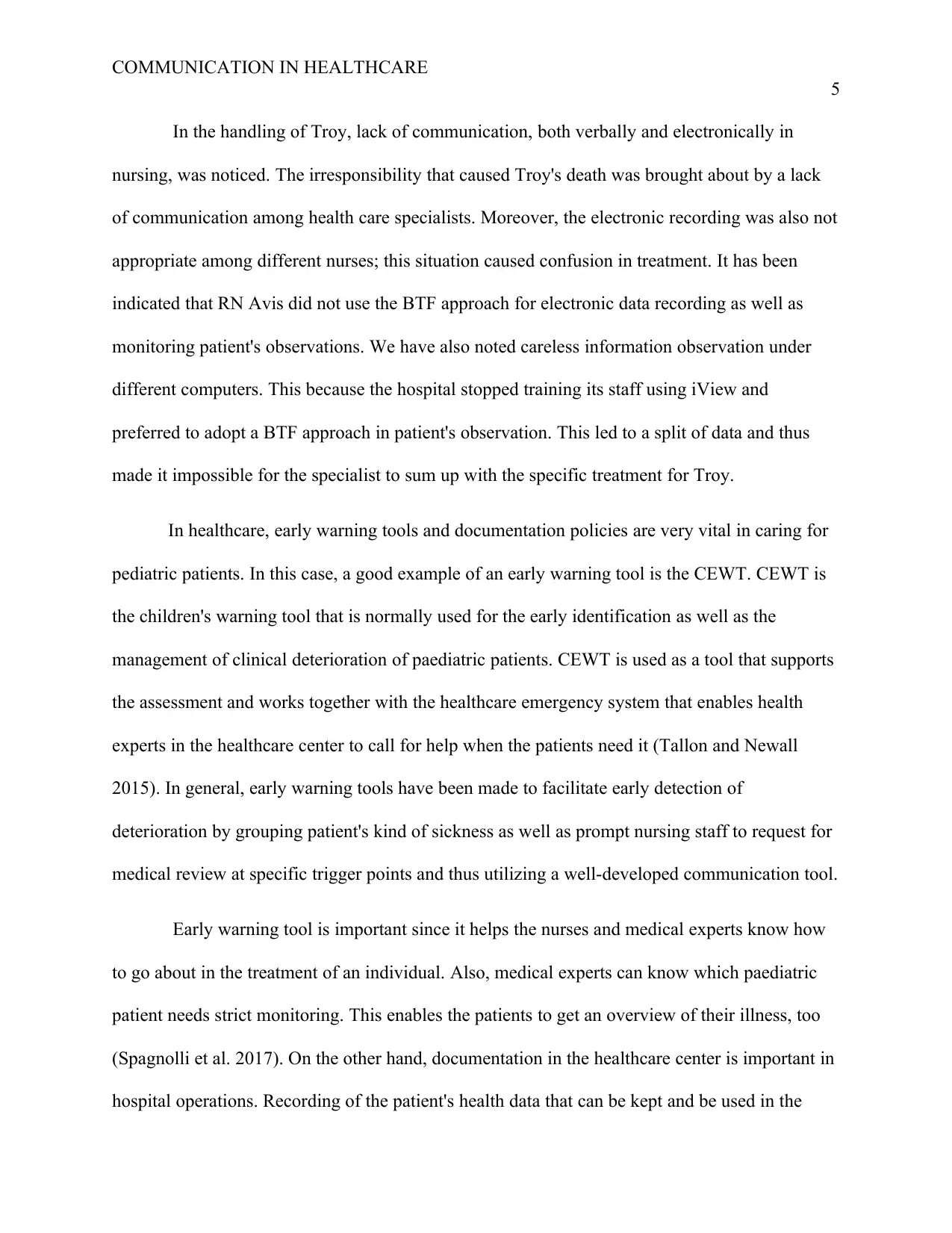
COMMUNICATION IN HEALTHCARE
5
In the handling of Troy, lack of communication, both verbally and electronically in
nursing, was noticed. The irresponsibility that caused Troy's death was brought about by a lack
of communication among health care specialists. Moreover, the electronic recording was also not
appropriate among different nurses; this situation caused confusion in treatment. It has been
indicated that RN Avis did not use the BTF approach for electronic data recording as well as
monitoring patient's observations. We have also noted careless information observation under
different computers. This because the hospital stopped training its staff using iView and
preferred to adopt a BTF approach in patient's observation. This led to a split of data and thus
made it impossible for the specialist to sum up with the specific treatment for Troy.
In healthcare, early warning tools and documentation policies are very vital in caring for
pediatric patients. In this case, a good example of an early warning tool is the CEWT. CEWT is
the children's warning tool that is normally used for the early identification as well as the
management of clinical deterioration of paediatric patients. CEWT is used as a tool that supports
the assessment and works together with the healthcare emergency system that enables health
experts in the healthcare center to call for help when the patients need it (Tallon and Newall
2015). In general, early warning tools have been made to facilitate early detection of
deterioration by grouping patient's kind of sickness as well as prompt nursing staff to request for
medical review at specific trigger points and thus utilizing a well-developed communication tool.
Early warning tool is important since it helps the nurses and medical experts know how
to go about in the treatment of an individual. Also, medical experts can know which paediatric
patient needs strict monitoring. This enables the patients to get an overview of their illness, too
(Spagnolli et al. 2017). On the other hand, documentation in the healthcare center is important in
hospital operations. Recording of the patient's health data that can be kept and be used in the
5
In the handling of Troy, lack of communication, both verbally and electronically in
nursing, was noticed. The irresponsibility that caused Troy's death was brought about by a lack
of communication among health care specialists. Moreover, the electronic recording was also not
appropriate among different nurses; this situation caused confusion in treatment. It has been
indicated that RN Avis did not use the BTF approach for electronic data recording as well as
monitoring patient's observations. We have also noted careless information observation under
different computers. This because the hospital stopped training its staff using iView and
preferred to adopt a BTF approach in patient's observation. This led to a split of data and thus
made it impossible for the specialist to sum up with the specific treatment for Troy.
In healthcare, early warning tools and documentation policies are very vital in caring for
pediatric patients. In this case, a good example of an early warning tool is the CEWT. CEWT is
the children's warning tool that is normally used for the early identification as well as the
management of clinical deterioration of paediatric patients. CEWT is used as a tool that supports
the assessment and works together with the healthcare emergency system that enables health
experts in the healthcare center to call for help when the patients need it (Tallon and Newall
2015). In general, early warning tools have been made to facilitate early detection of
deterioration by grouping patient's kind of sickness as well as prompt nursing staff to request for
medical review at specific trigger points and thus utilizing a well-developed communication tool.
Early warning tool is important since it helps the nurses and medical experts know how
to go about in the treatment of an individual. Also, medical experts can know which paediatric
patient needs strict monitoring. This enables the patients to get an overview of their illness, too
(Spagnolli et al. 2017). On the other hand, documentation in the healthcare center is important in
hospital operations. Recording of the patient's health data that can be kept and be used in the

COMMUNICATION IN HEALTHCARE
6
determination of the patient's health history. By so doing, it is easy to keep track of patient's
health progress. Documentation also ensures no confusion arises between the health experts
during the treatment of the patient. Another importance of documentation is to ensure no errors
during treatment.
Ryan's rules are defined as a process that is used to help patients as well as their families
to report to medical care in case their patient's health is not improving (Nelson et al. 2019). In
paediatrics, this rule urges parents to report to the healthcare center in case their children are
having health issues. Having a head that brief definition, it is logical to have this rule applied and
implemented into registered nurse practice to ensure children receive treatment whenever they
are ill. Moreover, this rule enhances communication in healthcare (Dwyer et al., 2020).
Communication here maybe is verbally or electronically since these rules apply only for patients
that are within the healthcare center or those who are receiving treatment services through the
hospital in-home service. Another reason Ryan's rule should be applied and implemented to RN
practice is that it helps people and healthcare experts work together in case of treatment need.
This builds a good relationship between the society and the health care experts.
From the case of Troy's death, we saw missed opportunities for communication that
created a gap in healthcare operations. However, some strategies have been developed to reduce
this risk. One of these strategies is to ensure that nurses cooperate in working together to
evaluate the data taken from a patient. By evaluating this information, communication has been
developed, and thus minimal errors are likely to occur. Another strategy is that nurses should
always do their job keenly and professionally. Data recording and storage should be done in one
platform to ensure that data does not split and thus ensures an easy way to monitor a patient’s
health development. It is the responsibility of treating specialists to ensure a patient is well
6
determination of the patient's health history. By so doing, it is easy to keep track of patient's
health progress. Documentation also ensures no confusion arises between the health experts
during the treatment of the patient. Another importance of documentation is to ensure no errors
during treatment.
Ryan's rules are defined as a process that is used to help patients as well as their families
to report to medical care in case their patient's health is not improving (Nelson et al. 2019). In
paediatrics, this rule urges parents to report to the healthcare center in case their children are
having health issues. Having a head that brief definition, it is logical to have this rule applied and
implemented into registered nurse practice to ensure children receive treatment whenever they
are ill. Moreover, this rule enhances communication in healthcare (Dwyer et al., 2020).
Communication here maybe is verbally or electronically since these rules apply only for patients
that are within the healthcare center or those who are receiving treatment services through the
hospital in-home service. Another reason Ryan's rule should be applied and implemented to RN
practice is that it helps people and healthcare experts work together in case of treatment need.
This builds a good relationship between the society and the health care experts.
From the case of Troy's death, we saw missed opportunities for communication that
created a gap in healthcare operations. However, some strategies have been developed to reduce
this risk. One of these strategies is to ensure that nurses cooperate in working together to
evaluate the data taken from a patient. By evaluating this information, communication has been
developed, and thus minimal errors are likely to occur. Another strategy is that nurses should
always do their job keenly and professionally. Data recording and storage should be done in one
platform to ensure that data does not split and thus ensures an easy way to monitor a patient’s
health development. It is the responsibility of treating specialists to ensure a patient is well
⊘ This is a preview!⊘
Do you want full access?
Subscribe today to unlock all pages.

Trusted by 1+ million students worldwide
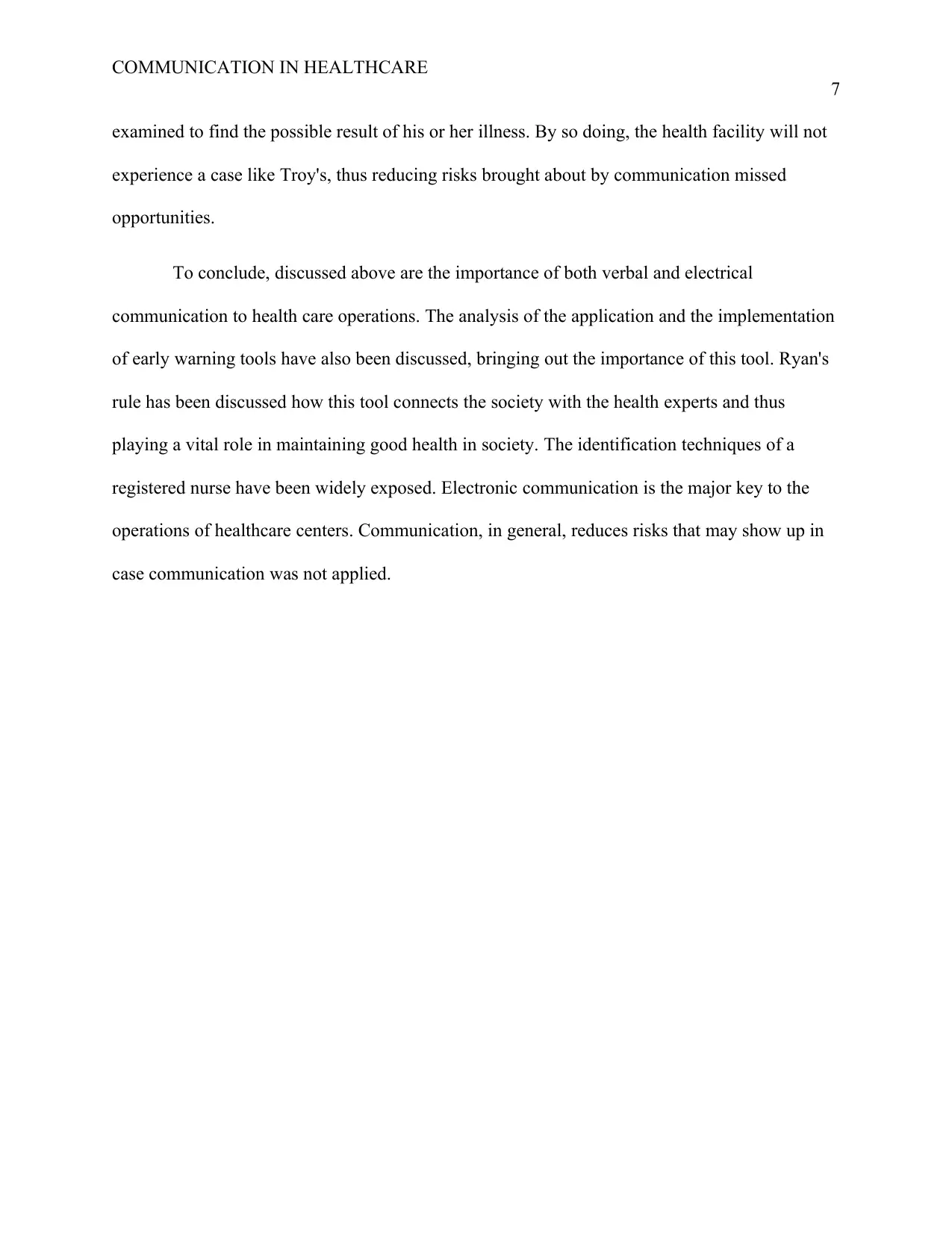
COMMUNICATION IN HEALTHCARE
7
examined to find the possible result of his or her illness. By so doing, the health facility will not
experience a case like Troy's, thus reducing risks brought about by communication missed
opportunities.
To conclude, discussed above are the importance of both verbal and electrical
communication to health care operations. The analysis of the application and the implementation
of early warning tools have also been discussed, bringing out the importance of this tool. Ryan's
rule has been discussed how this tool connects the society with the health experts and thus
playing a vital role in maintaining good health in society. The identification techniques of a
registered nurse have been widely exposed. Electronic communication is the major key to the
operations of healthcare centers. Communication, in general, reduces risks that may show up in
case communication was not applied.
7
examined to find the possible result of his or her illness. By so doing, the health facility will not
experience a case like Troy's, thus reducing risks brought about by communication missed
opportunities.
To conclude, discussed above are the importance of both verbal and electrical
communication to health care operations. The analysis of the application and the implementation
of early warning tools have also been discussed, bringing out the importance of this tool. Ryan's
rule has been discussed how this tool connects the society with the health experts and thus
playing a vital role in maintaining good health in society. The identification techniques of a
registered nurse have been widely exposed. Electronic communication is the major key to the
operations of healthcare centers. Communication, in general, reduces risks that may show up in
case communication was not applied.
Paraphrase This Document
Need a fresh take? Get an instant paraphrase of this document with our AI Paraphraser
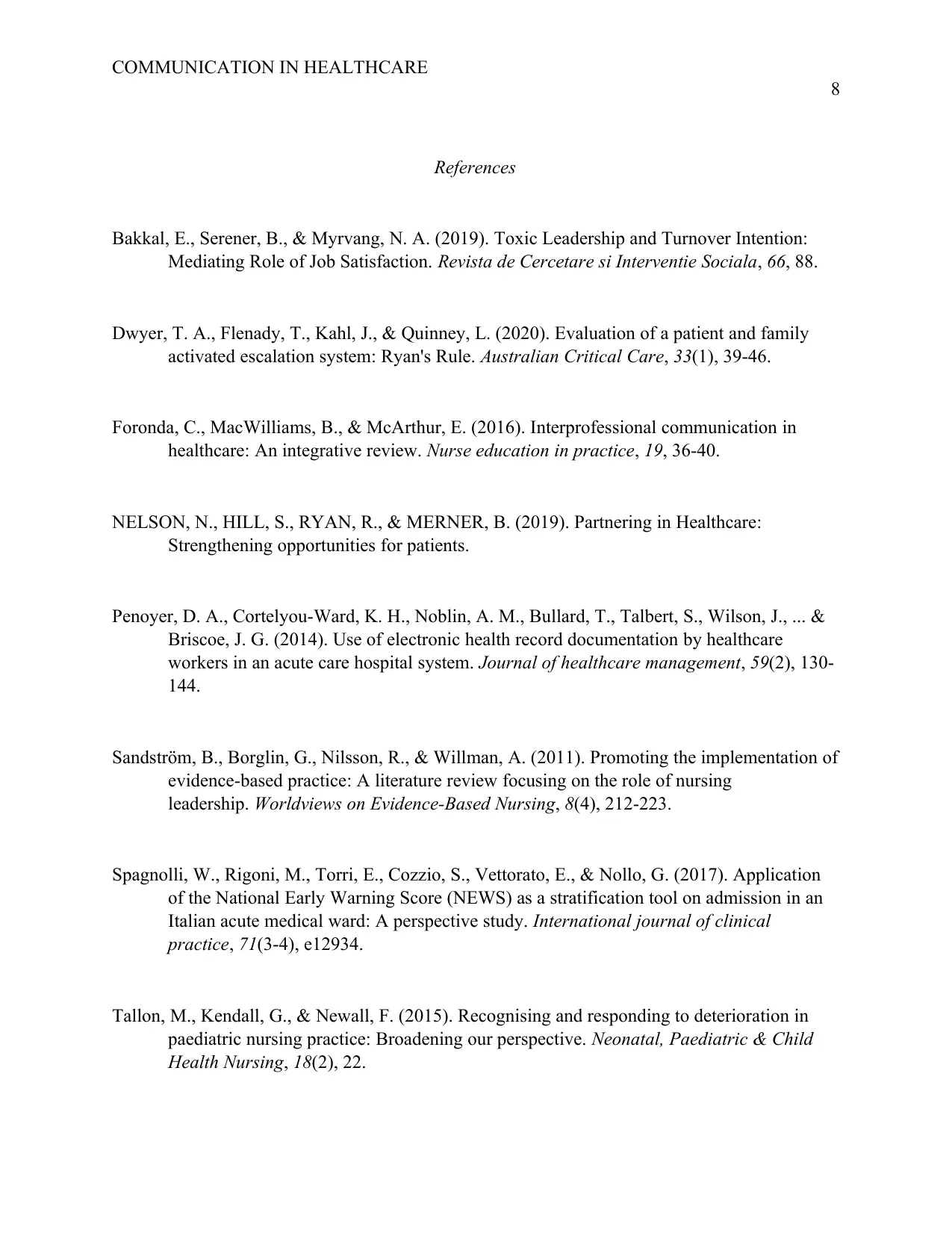
COMMUNICATION IN HEALTHCARE
8
References
Bakkal, E., Serener, B., & Myrvang, N. A. (2019). Toxic Leadership and Turnover Intention:
Mediating Role of Job Satisfaction. Revista de Cercetare si Interventie Sociala, 66, 88.
Dwyer, T. A., Flenady, T., Kahl, J., & Quinney, L. (2020). Evaluation of a patient and family
activated escalation system: Ryan's Rule. Australian Critical Care, 33(1), 39-46.
Foronda, C., MacWilliams, B., & McArthur, E. (2016). Interprofessional communication in
healthcare: An integrative review. Nurse education in practice, 19, 36-40.
NELSON, N., HILL, S., RYAN, R., & MERNER, B. (2019). Partnering in Healthcare:
Strengthening opportunities for patients.
Penoyer, D. A., Cortelyou-Ward, K. H., Noblin, A. M., Bullard, T., Talbert, S., Wilson, J., ... &
Briscoe, J. G. (2014). Use of electronic health record documentation by healthcare
workers in an acute care hospital system. Journal of healthcare management, 59(2), 130-
144.
Sandström, B., Borglin, G., Nilsson, R., & Willman, A. (2011). Promoting the implementation of
evidence‐based practice: A literature review focusing on the role of nursing
leadership. Worldviews on Evidence‐Based Nursing, 8(4), 212-223.
Spagnolli, W., Rigoni, M., Torri, E., Cozzio, S., Vettorato, E., & Nollo, G. (2017). Application
of the National Early Warning Score (NEWS) as a stratification tool on admission in an
Italian acute medical ward: A perspective study. International journal of clinical
practice, 71(3-4), e12934.
Tallon, M., Kendall, G., & Newall, F. (2015). Recognising and responding to deterioration in
paediatric nursing practice: Broadening our perspective. Neonatal, Paediatric & Child
Health Nursing, 18(2), 22.
8
References
Bakkal, E., Serener, B., & Myrvang, N. A. (2019). Toxic Leadership and Turnover Intention:
Mediating Role of Job Satisfaction. Revista de Cercetare si Interventie Sociala, 66, 88.
Dwyer, T. A., Flenady, T., Kahl, J., & Quinney, L. (2020). Evaluation of a patient and family
activated escalation system: Ryan's Rule. Australian Critical Care, 33(1), 39-46.
Foronda, C., MacWilliams, B., & McArthur, E. (2016). Interprofessional communication in
healthcare: An integrative review. Nurse education in practice, 19, 36-40.
NELSON, N., HILL, S., RYAN, R., & MERNER, B. (2019). Partnering in Healthcare:
Strengthening opportunities for patients.
Penoyer, D. A., Cortelyou-Ward, K. H., Noblin, A. M., Bullard, T., Talbert, S., Wilson, J., ... &
Briscoe, J. G. (2014). Use of electronic health record documentation by healthcare
workers in an acute care hospital system. Journal of healthcare management, 59(2), 130-
144.
Sandström, B., Borglin, G., Nilsson, R., & Willman, A. (2011). Promoting the implementation of
evidence‐based practice: A literature review focusing on the role of nursing
leadership. Worldviews on Evidence‐Based Nursing, 8(4), 212-223.
Spagnolli, W., Rigoni, M., Torri, E., Cozzio, S., Vettorato, E., & Nollo, G. (2017). Application
of the National Early Warning Score (NEWS) as a stratification tool on admission in an
Italian acute medical ward: A perspective study. International journal of clinical
practice, 71(3-4), e12934.
Tallon, M., Kendall, G., & Newall, F. (2015). Recognising and responding to deterioration in
paediatric nursing practice: Broadening our perspective. Neonatal, Paediatric & Child
Health Nursing, 18(2), 22.
1 out of 8
Related Documents
Your All-in-One AI-Powered Toolkit for Academic Success.
+13062052269
info@desklib.com
Available 24*7 on WhatsApp / Email
![[object Object]](/_next/static/media/star-bottom.7253800d.svg)
Unlock your academic potential
Copyright © 2020–2025 A2Z Services. All Rights Reserved. Developed and managed by ZUCOL.





